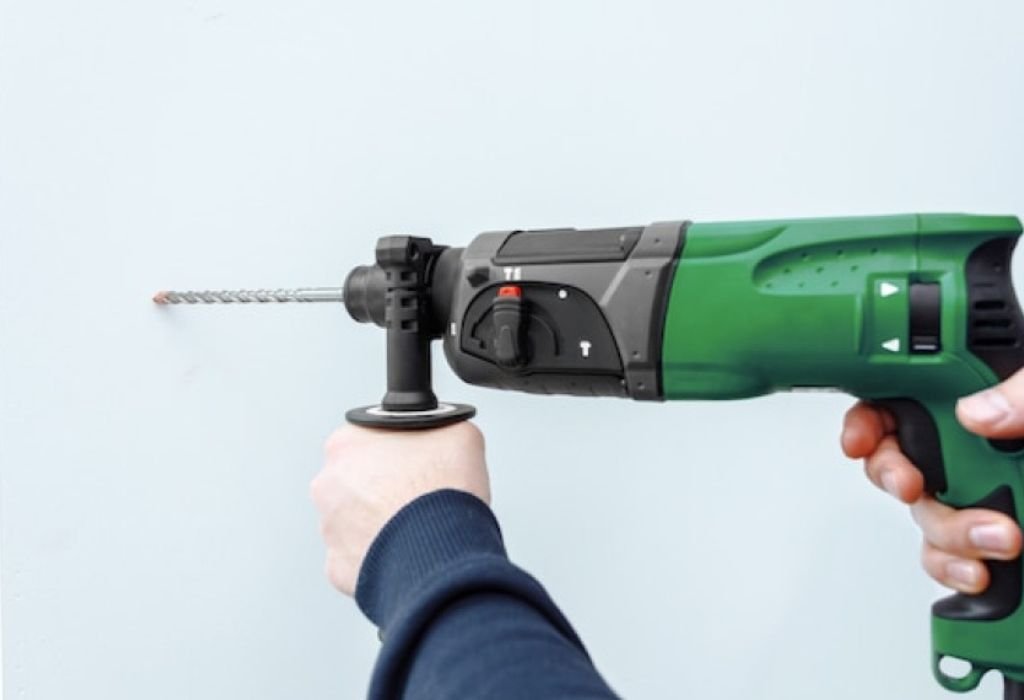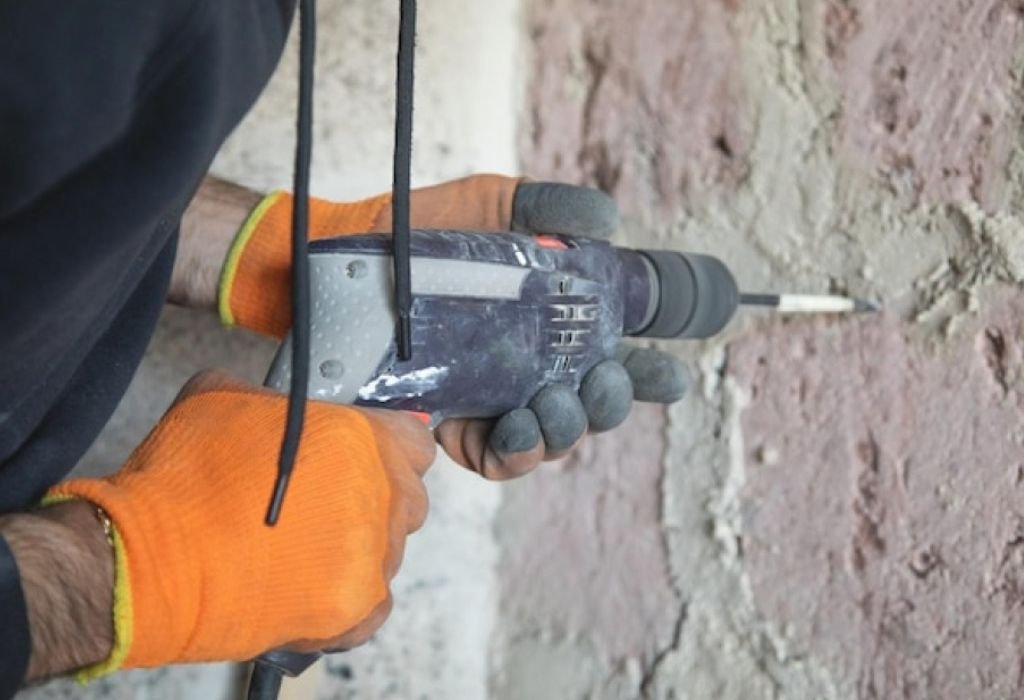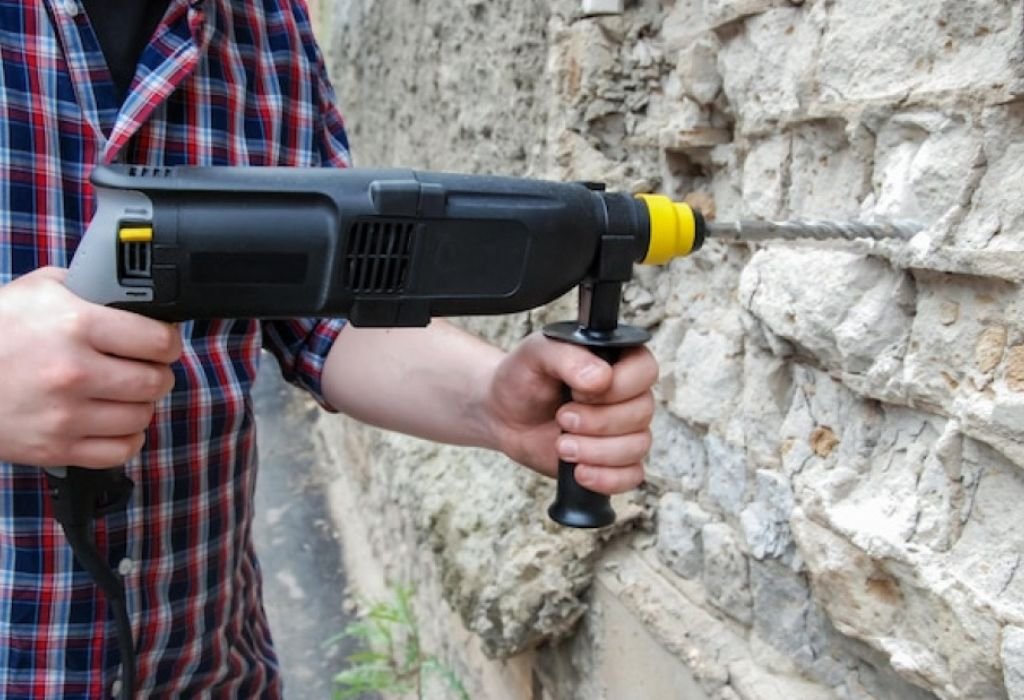Imagine standing on a construction site with a standard drill in hand.
You push against a wall of reinforced concrete, but the bit struggles, the motor whines, and progress feels painfully slow.
This is the reality many workers face when they attempt heavy-duty jobs with the wrong tools.
Regular drills and even hammer drills can only go so far before performance drops. For professionals who deal with concrete, stone, or masonry every day, a stronger solution is needed.
The rotary hammer is that solution. It is designed specifically to handle dense materials with ease.
By combining rotation with pneumatic hammering, it allows workers to cut through concrete and brick like a hot knife through butter.
The global power tool market is booming, expected to surpass $41 billion by 2027, and rotary hammers are at the center of this growth (Statista).
Their efficiency, durability, and versatility make them indispensable in construction, demolition, and renovation projects.
What Is a Rotary Hammer?

A rotary hammer is a power tool built to drill and chisel hard materials. Unlike a hammer drill, it uses a piston-driven mechanism that delivers strong, repetitive blows while rotating the bit. This combination makes it much more effective on thick concrete and masonry.
The tool’s design allows it to operate with less effort from the user. Instead of forcing the bit into the material, the hammering action does the heavy lifting. This reduces fatigue and makes large projects more manageable.
Rotary hammers come in different sizes and power levels. Smaller models are suited for light construction or DIY projects, while larger SDS Max machines dominate professional job sites. The right choice depends on the scale of work and the material being tackled.
In essence, a rotary hammer is not just a drill. It is a specialized tool that bridges the gap between drilling and light demolition, offering unmatched performance where other tools fail.
What makes a rotary hammer different from a drill?
It adds a pneumatic hammering force to the rotary motion.
Is it the same as a hammer drill?
No, it is more powerful and durable.
Can it be used on metal or wood?
Yes, but it’s better reserved for stone, brick, and concrete.
Are rotary hammers available cordless?
Yes, modern cordless versions rival corded models.
What industries use them most?
Construction, renovation, demolition, and masonry work.
Primary Uses of a Rotary Hammer
Rotary hammers shine in situations where strength and endurance are required. The most common use is drilling holes in reinforced concrete. Tasks like installing anchors or bolts demand precise holes that only a rotary hammer can deliver efficiently.
Another primary use is chiseling. By switching to a flat or pointed chisel bit, the rotary hammer can remove tiles, break plaster, or chip away at old mortar. This makes it a versatile tool not just for building but also for demolition and repair.
Rotary hammers are also essential for stonework. Masons rely on them to drill into hard rock or shape stone blocks. Unlike lighter drills, rotary hammers maintain power and accuracy even under extreme pressure.
Finally, large construction projects such as tunnel building, bridge reinforcement, and roadwork rely heavily on rotary hammers. Their durability makes them suitable for repeated, heavy-duty tasks that demand consistency.
Q&A:
Can homeowners use rotary hammers?
Yes, but they are most useful for concrete-heavy projects.
Is it good for removing tiles?
Yes, a flat chisel bit makes tile removal fast and easy.
Does it replace a jackhammer?
Not completely, but it handles lighter demolition jobs.
Why is it better than a hammer drill?
It has more impact energy and durability.
Is it used in large projects?
Yes, especially in tunnels, bridges, and roadwork.
Rotary Hammer vs. Hammer Drill
It’s easy to confuse rotary hammers with hammer drills, but their differences are significant. A hammer drill uses a simple mechanical action that adds vibration to the drilling motion. This helps with light masonry, but it struggles with dense concrete.
A rotary hammer, on the other hand, uses a piston-driven system that delivers much stronger impacts. The result is faster drilling with less effort from the user. In side-by-side tests, rotary hammers outperform hammer drills in both speed and longevity.
Hammer drills are lighter and cheaper, which makes them attractive for small DIY projects. However, their lifespan drops quickly under professional workloads. Rotary hammers are built to withstand hours of daily use without overheating or breaking down.
Choosing between the two depends on the job. For homeowners installing a few shelves in a brick wall, a hammer drill may be enough. For professionals who regularly deal with reinforced concrete, only a rotary hammer will deliver consistent results.
Which tool is better for brick walls?
A rotary hammer handles the job more efficiently.
Is a hammer drill more affordable?
Yes, but it is less powerful.
Do both tools use SDS bits?
Rotary hammers typically do, hammer drills usually don’t.
Can they be used for the same jobs?
Yes, but rotary hammers excel in heavier tasks.
Which lasts longer in tough conditions?
Rotary hammers are designed for heavy-duty durability.
Types of Rotary Hammers: SDS Plus vs. SDS Max
Rotary hammers are often categorized by their chuck system. SDS Plus models are smaller, designed for light to medium drilling tasks. They are commonly used in residential or light commercial work.
SDS Max models are much larger and built for industrial use. They can handle big drill bits and chisels, making them ideal for demolition or drilling large holes in concrete. Their power output is significantly higher than SDS Plus.
There are also cordless rotary hammers that use advanced lithium-ion batteries. These provide mobility without sacrificing too much power. As technology improves, cordless tools are becoming more common on professional sites.
Choosing between SDS Plus and SDS Max depends on workload. For light-duty users, SDS Plus is cost-effective and portable. For heavy-duty professionals, SDS Max delivers the power required for demanding jobs.
What does SDS mean?
It stands for “Slotted Drive System.”
Which is more powerful, SDS Plus or SDS Max?
SDS Max is designed for heavy-duty applications.
Are cordless versions reliable?
Yes, modern batteries provide strong performance.
Which type should homeowners choose?
SDS Plus is usually sufficient for home use.
Can SDS Max bits fit SDS Plus tools?
No, the systems are not interchangeable.
How Does a Rotary Hammer Work?

Understanding how a rotary hammer works helps explain its strength. At its core, it uses a piston mechanism powered by electricity or batteries. The piston compresses air, driving the bit forward with powerful hammering action.
This system is different from the cam mechanism in hammer drills. The pneumatic system generates more impact energy while reducing wear and tear on internal parts. This means rotary hammers last longer under heavy use.
The hammering force is measured in joules of impact energy. Entry-level rotary hammers may deliver 2–3 joules, while professional SDS Max models can exceed 10 joules. The higher the number, the more efficient the drilling or chiseling.
This combination of power and efficiency makes rotary hammers ideal for repetitive tasks. Workers can drill multiple holes or break large surfaces without overexertion.
What powers the hammering action?
A piston system that compresses air.
How is it different from a hammer drill?
It uses pneumatic force, not a cam system.
What is impact energy measured in?
Joules, indicating power per strike.
Do higher joules mean faster drilling?
Yes, more energy equals better performance.
Is the mechanism durable?
Yes, it is built for long-term heavy use.
Safety Tips for Using a Rotary Hammer
Rotary hammers are powerful tools, and safety should always come first. The high impact energy and vibration can cause strain if not managed properly.
Workers must wear protective gear including goggles, gloves, and ear defenders. Concrete dust is another hazard, so masks or respirators are often required on job sites.
Proper handling is equally important. Always use both hands to maintain control, especially when drilling into reinforced concrete. Sudden changes in resistance can cause kickback.
Regular breaks help prevent fatigue. Extended use without rest can lead to hand-arm vibration syndrome (HAVS), a serious condition caused by long-term exposure to vibration.
Do rotary hammers cause vibration?
Yes, though many have anti-vibration features.
Is hearing protection necessary?
Yes, noise levels are often high.
Can gloves reduce fatigue?
Yes, padded gloves help with comfort.
Do bits need inspection?
Yes, worn bits can break and cause accidents.
Are cordless models safer?
They reduce cord-related hazards but need safe handling.
Attachments and Accessories for Rotary Hammers
Rotary hammers become more versatile with the right accessories. The most common are SDS Plus and SDS Max drill bits, designed for concrete and stone drilling.
Chisel attachments expand functionality, allowing the tool to remove tiles, chip away plaster, or even break light concrete. Point chisels are used for concentrated breaking, while flat chisels handle wider surfaces.
Core bits are another important accessory. They create large holes in walls or floors, often for plumbing or electrical installations. These bits are reinforced to handle rebar inside concrete.
Maintaining bits is critical. Regular cleaning, lubrication, and inspection extend their lifespan and ensure efficiency. A well-maintained bit performs better and keeps the tool safe.
What does SDS stand for?
Slotted Drive System, for quick bit changes.
Can core bits cut through rebar?
Yes, reinforced designs can handle steel.
Is lubrication important?
Yes, it reduces wear and overheating.
Do chisels expand tool use?
Yes, they allow for demolition and tile removal.
Are accessories interchangeable?
Only within their SDS system.
When to Choose a Rotary Hammer Over Other Tools
Not every project requires a rotary hammer, but for tough jobs, it’s the best choice. If you need to drill anchor holes in reinforced concrete, a standard drill won’t cut it. A rotary hammer makes the process faster and cleaner.
For demolition, rotary hammers are an excellent choice for lighter jobs. Removing tiles, breaking up old mortar, or chipping concrete becomes manageable with the right chisel attachment.
In large-scale projects, efficiency matters. Rotary hammers save time by completing repetitive drilling tasks quickly, reducing labor costs and increasing productivity.
DIYers should consider whether their projects justify the investment. For occasional work in wood or light materials, a drill is enough. But for concrete-heavy tasks, a rotary hammer is a worthwhile addition.
Q&A:
Should homeowners buy one?
Only if tackling concrete or masonry projects.
Is it overkill for wood projects?
Yes, regular drills are better.
Do professionals always carry one?
Yes, they are standard on job sites.
Does it save time?
Yes, it drastically reduces work time.
Is it cost-effective?
Yes, especially for long-term heavy use.
Maintaining a Rotary Hammer for Longevity

Like all tools, rotary hammers require care to last. Regular maintenance keeps them efficient and prevents costly breakdowns.
Cleaning after use is essential. Concrete dust can clog vents and reduce performance. Compressed air is often used to clear debris.
Lubrication of the chuck and bits ensures smooth operation. Some models require periodic greasing of the piston system. Following manufacturer instructions is key.
Storage also matters. Tools should be kept in dry, dust-free cases. Batteries in cordless models should be charged properly to extend their lifespan.
Do rotary hammers need regular cleaning?
Yes, dust buildup affects performance.
How often should lubrication be done?
Follow manufacturer guidelines, usually every few weeks.
Do batteries require special care?
Yes, avoid overcharging and extreme heat.
Is storage important?
Yes, dry and clean environments prevent damage.
Does maintenance extend lifespan?
Absolutely, it ensures years of reliable service.
Conclusion
A rotary hammer is more than just a power tool. It is the go-to solution for construction workers, masons, and DIYers facing tough materials like concrete and stone. Its combination of drilling and hammering action makes it far superior to regular drills and hammer drills in heavy-duty applications.
From drilling anchors to chiseling tiles, rotary hammers offer speed, precision, and endurance. With the right attachments, they transform from simple drills into versatile demolition tools.
Safety and maintenance remain vital. Proper gear, careful handling, and regular upkeep ensure both the tool and the user stay protected.
In 2025 and beyond, rotary hammers will remain essential in construction. For anyone asking what is a rotary hammer used for, the answer is simple: it’s used to make the hardest jobs easier, faster, and more reliable.

I’m John F. Nicholas, the founder, lead writer, and drill enthusiast behind 101drill.com. With years of hands-on experience in power tools and DIY projects, I created this platform to share practical knowledge, expert tips, and real-world insights to help others master the art of drilling.
